Gray Mountain
Posted on: December 5, 2014
Author(s): John Grisham
Genre : Legal Fiction (Issue based)
Series: –
Pages : 386 pages
Publication Year: 23 October 2014
Is Review Spoiler: No
Rating: 2 stars (out of 5)
Buy: You can get it from here.
—————————————————————————————————————————
Let’s get to the point straight away – this story revolves around Samantha Kofer, a third year associate at prestigious law firm but when Lehman Brothers collapses and US is hit with major recession in 2008 – she gets downsized, furloughed, escorted out of the building. Her firm gives her an option of keeping health insurance for a year if she take a Pro-Bono work and only option she gets is the becoming an intern in a legal clinic in Virginia‘s coal mining country.
Legal clinic basic deal with Pro-Bono work specially related to coal mining, like handling the cases of cola miners who got black lung diseases (a diseases which is common with coal miners) filling the law suits against coal mining companies. Other issue this clinic deals with is “Strip Mining” – in which cola companies will remove mountain top to get the coal instead of tunneling the mountain. Strip Mining has a huge impact on nature and surrounding areas, the coal companies will store the toxic wastes in the dams constructed nearby the town and there is high risk that these dams will flood and toxic waste will be spread throughout the villages resulting in many diseases.
Now coming to the problem with the story – Once Samantha Kofer joins legal clinic in Virginia to keep her health insurance, the story started to become too much preachy, I mean literally preachy, almost 50 to 60 % of book was spent in explaining the problems with coal mining and specially strip mining. Once we get over the preachy part regarding coal mining we will come across usual divorce cases, property disputes cases etc which cover almost 20% of the book. The problem is if you are regular John Grisham reader, you will immediately see the repetitions because we have already read the same old cases in many of his books, then what’s the point of adding them here? May for new JG readers?
Rest 20% book deals with the case of two boys who died in their home when a huge stone from nearby mountain fell on there house and lawsuit against evil coal mining company which is dumping toxic wastes in rivers resulting in many disease. Just when you thinks the story is going somewhere, again we hit a road block and it ends without any end!
This is one of the weakest John Grisham Novel I have read so far and if you are thinking of reading it – I will say, avoid this one and wait for his next novel.
Excerpts from book:
The year is 2008 and Samantha Kofer’s career at a huge Wall Street law firm is on the fast track—until the recession hits and she gets downsized, furloughed, escorted out of the building. Samantha, though, is one of the “lucky” associates. She’s offered an opportunity to work at a legal aid clinic for one year without pay, after which there would be a slim chance that she’d get her old job back.
In a matter of days Samantha moves from Manhattan to Brady, Virginia, population 2,200, in the heart of Appalachia, a part of the world she has only read about. Mattie Wyatt, lifelong Brady resident and head of the town’s legal aid clinic, is there to teach her how to “help real people with real problems.” For the first time in her career, Samantha prepares a lawsuit, sees the inside of an actual courtroom, gets scolded by a judge, and receives threats from locals who aren’t so thrilled to have a big-city lawyer in town. And she learns that Brady, like most small towns, harbors some big secrets.
Her new job takes Samantha into the murky and dangerous world of coal mining, where laws are often broken, rules are ignored, regulations are flouted, communities are divided, and the land itself is under attack from Big Coal. Violence is always just around the corner, and within weeks Samantha finds herself engulfed in litigation that turns deadly.
I Am Malala
Posted on: October 20, 2014
Name: I Am Malala
Author(s):
Genre : biography, non-fiction
Series: —
Pages : 289 pages
Publication Year: 8 October 2013
Is Review Spoiler: No
Rating: 4 stars (out of 5)
Buy: You can get it from here.
—————————————————————————————————————————
Malala – you might have heard this name – recently – she is THE YOUNGEST RECIPIENT OF THE NOBEL PEACE PRIZE. You might be thinking – what she did to earn noble peace prize?
My friends say he fired three shots, one after another. The first went through my left eye socket and out under my left shoulder. I slumped forward onto Moniba, blood coming from my left ear, so the other two bullets hit the girls next to me. One bullet went into Shazia’s left hand. The third went through her left shoulder and into the upper right arm of Kainat Riaz.
This is the story of a girl shot down by the Taliban. Most of us knew her as a girl shot down by Taliban for opposing them and supporting education of girls but before she was shot down by Taliban – she was a star campaigner for girl rights and won many awards and even won the maiden “National Youth Peace Prize awarded her on 19 December 2011 by Prime Minister Yousaf Raza Gilani for her services towards promoting girls’ education in her hometown of Mingora in the Swat Valley, where the Taliban had banned girls from attending school.” Now this prize is known by her name “National Malala Peace Prize”.
Malala born in a pious Sunni Muslim family of Pashtun ethnicity in the year 12 July 1997. Her father gave her the name Malala which means “grief-stricken” after Malalai of Maiwand, a famous Pashtun poetess and warrior woman from southern Afghanistan.
I would say her father Ziauddin Yousafzai is a real hero and inspiration to Malala for standing up for girls rights in Swat valley after Taliban invasion. Her father Ziauddin – who came from a middle class family opened a school in Swat valley for girls with the help of his friends and named it “Khushal Public School” named after a famous Pashtun poet, Khushal Khan Khattak.
Before the advent of Taliban in Swat valley – her life and Swat valley were both very peaceful and girls school was running without much problem apart from small opposition. But when US invaded Afghanistan to remove Taliban – instead of removing Taliban from that region they moved them from Afghanistan to Pakistan.
When Taliban first appeared in Swat Valley – they started their activities – first by broadcasting a religious sermons on FM Radio station and everyone in Swat valley loved their sermons. Then they started helping needy and contributing in relief works when there was a earthquake in Pakistan. After gaining the support of people – they started giving religious fatwa’s on Radio and told everyone in Swat valley to stop listening to music, watching movies and dancing. Then they banned girls from going to the school saying it’s against Islam where as Islam is in favor of girls education.
Islam encouraged religious education of Muslim women. According to a hadith attributed to Prophet Muhammad (Blessing and Peace be upon him), he (Blessing and Peace be upon him) praised the women of Medina because of their desire for religious knowledge:
“How splendid were the women of the Ansar; shame did not prevent them from becoming learned in the faith.”
At various other times, the Prophet Muhammad (Blessing and Peace be upon him) told his followers:
1. “Acquisition of knowledge is binding on all Muslims, male and female.”
2. “Seek knowledge, from the cradle to the grave.”
3. “Acquire knowledge, even if you have to go to China for it.”
4. “The person who goes forth in search of knowledge is striving hard in the way of Allah, until his/her return
“It is impossible to be a Muslim, to live according to the requirements of Islam, and at the same time live in a state of ignorance.” – FOMWAN
So, when Taliban banned girls education from Swat valley – Malala raised her voice against them and she started campaign in favor of girls education.
She get’s inspiration from her father who was foremost to fight for girls rights in Swat Valley, as she put’s it about her father:
He hated the fact that most people would not speak up. In his pocket he kept a poem written by Martin Niemöller, who had lived in Nazi Germany.
First they came for the communists, and I didn’t speak out because I wasn’t a communist.
Then they came for the socialists, and I didn’t speak out because I wasn’t a socialist.
Then they came for the trade unionists, and I didn’t speak out because I wasn’t a trade unionist.
Then they came for the Jews, and I didn’t speak out because I was not a Jew.
Then they came for the Catholics, and I didn’t speak out because I was not a Catholic.
Then they came for me, and there was no one left to speak for me.
The book beautifully portrays the life of Malala and brings to light many unknown facts about her life before she got shot. One of those thing I didn’t know was this: She started writing a blog for BBC Urdu in 2009 as “Gul Makai” (“cornflower” in Urdu), a name taken from a character in a Pashtun folktale. The blog records Yousafzai’s thoughts during the First Battle of Swat, as military operations take place, fewer girls show up to school, and finally, her school shuts down.
I would recommend this book to anyone who want’s know about the courageous girl who stood against Taliban for her rights.
Excerpts from book:
I come from a country that was created at midnight. When I almost died it was just after midday.
When the Taliban took control of the Swat Valley in Pakistan, one girl spoke out. Malala Yousafzai refused to be silenced and fought for her right to an education.
On Tuesday, October 9, 2012, when she was fifteen, she almost paid the ultimate price. She was shot in the head at point-blank range while riding the bus home from school, and few expected her to survive.
Instead, Malala’s miraculous recovery has taken her on an extraordinary journey from a remote valley in northern Pakistan to the halls of the United Nations in New York. At sixteen, she has become a global symbol of peaceful protest and the youngest nominee ever for the Nobel Peace Prize.
I Am Malala is the remarkable tale of a family uprooted by global terrorism, of the fight for girls’ education, of a father who, himself a school owner, championed and encouraged his daughter to write and attend school, and of brave parents who have a fierce love for their daughter in a society that prizes sons.
I Am Malala will make you believe in the power of one person’s voice to inspire change in the world
Sufi Comics: Rumi
Posted on: September 2, 2014
- In: Comics
- 3 Comments
Author: Mohammed Ali Vakil, Mohammed Arif Vakil
Genre : Comics, Sufi Comics
Series: Sufi Comics #3
Pages : 180+ pages
Publication Year: 30 August 2014
Is Review Spoiler: No
Rating: 5 stars (out of 5)
Buy: You can get it from here.
—————————————————————————————————————————
Ever since I read Jalāl ad-Dīn Muḥammad Balkhī’s (is also known as Jalāl ad-Dīn Muḥammad Rūmī’s) Masnavi – I am completely Rumified. His magical and spritual words will leave you wanting more, such is the writing of Rumi.
Born in the village of Wakhsh, a small town located at the river Wakhsh in Persia (in what is now Tajikistan) in the year 30 September 1207.
When I was reading book 3 of Masnavi, I heard that Vakil brothers are going to publish a comic on Rumi, Since that day I was wondering which stories will they pick up from the wast collections of stories in Masnavi. One more thing which made me restless and curious to read this book was – how the stories will be rendered? will it match my imagination or better than that?
When I read the comic book and the stories in it – they are way better than what I imagined they might look like in comic form. The book is divided into different chapters,each chapter will tell a spiritually illuminating story, the first one is the story which will tell the origins of Rumi – How Rumi became Rumi. Origin story is beautifully illustrated by Rahil Mohsin and conveys to user the true origins of Rumi. I didn’t knew before reading this story that Rumi and His father met Ibn Al-Arabi (the greatest Sufi master) and how he uttered when he saw Rumi and His father – “There goes the sea followed by ocean!”.
The story I most liked and one of my favorite is the ‘Keep your dragon in snow’ – this story is awesomely illustrated and tells user that your Lower Self (Nafs) is never dead and don’t assume it to be otherwise. It’s exactly like a frozen dragon in snow – if you think it to be dead and bring it out in light of wanting-energy – it will brake out from freeze and kill you without showing the slightest mercy. So Keep your dragon in snow.
Another timeless tale which tells of annihilation of Self when you are on the path of Haqiqa [Reality] beautifully rendered and illustrated in the tale named “Since You Are I“. As one of the Sufi mystics puts it ‘When you are on the path of Sharia ‘I‘ is required and When you are on the path of Haqiqa there is no ‘I‘ ‘.
When we user our sensual eye we cannot see the world as a whole – because sensual eyes has limited visibility but if we user our intellectual (aqli) eye – it can cover the infinite boundaries of universe and see the world as whole. This point is illustrated beautifully in Sufi Comic’s ‘The Elephant in the Dark‘ tale.
Some Indian bring an elephant to be exhibited in a dark room. A number of men touch and feel the elephant in the dark and, depending upon where they touch it, they believe the elephant to be like a water spout (trunk), a fan (ear), a pillar (leg) and a throne (back). Rumi uses this story as an example of the limits of individual perception – as he puts it
“The sensual eye is just like the palm of the hand. The palm has not the means of covering the whole of the beast”.
“If each had a candle and they went in together the differences would disappear.”
Each story is followed by an Ayath of the Holy Quran and Sayings of Holy Prophet Muhammad (Blessings and peace be upon him) or Hazrath Ali (May Allah be pleased with him). Each Ayah/Saying is chosen to match the story.
Go ahead and read this wonderfully illustrated and spiritually illuminating tales from Rumi – in the comic form. I recommend this book to everyone who wants to read “Comics for the soul”.
In Search of Water – Sufi Comics
Posted on: August 18, 2014
- In: Uncategorized
- Leave a Comment
In Search of Water – Sufi Comics
In the name of Allah the Merciful and the Compassionate, and peace and blessings of Allah be upon our master the Prophet Muhammed.
Allah (The Glorified and the Exalted is He) has revealed to his beloved Messenger Muhammed (blessings and peace be upon him) in Holy Quran – 2:115:
“And to Allah belongs the east and the west. So wherever you [might] turn, there is the Face of Allah . Indeed, Allah is all-Encompassing and Knowing.”(Sahih International)
Alhamdulillah, the quest of the fish for finding the meaning of water after reading the ayath of Quran – 21:30 beautifully explains the Omnipresence of the Creator.
“Have those who disbelieved not considered that the heavens and the earth were a joined entity, and We separated them and made from water every living thing? Then will they not believe?” (21:30, Sahih International)
Have you ever reflected on the names of Allah (The…
View original post 590 more words

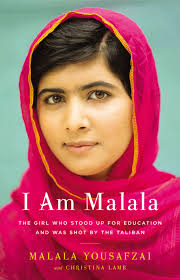
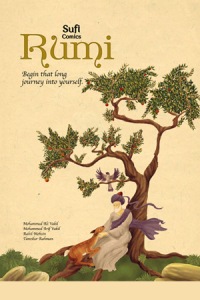
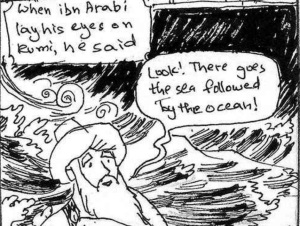
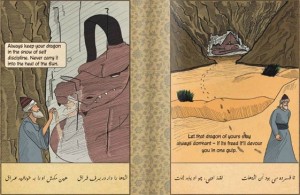
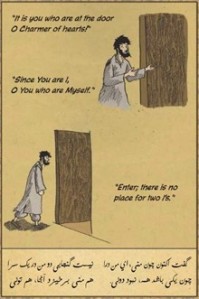
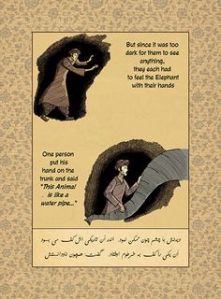
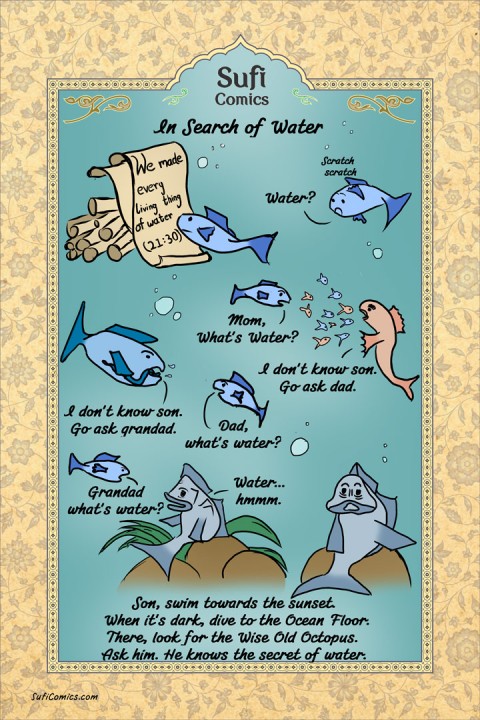
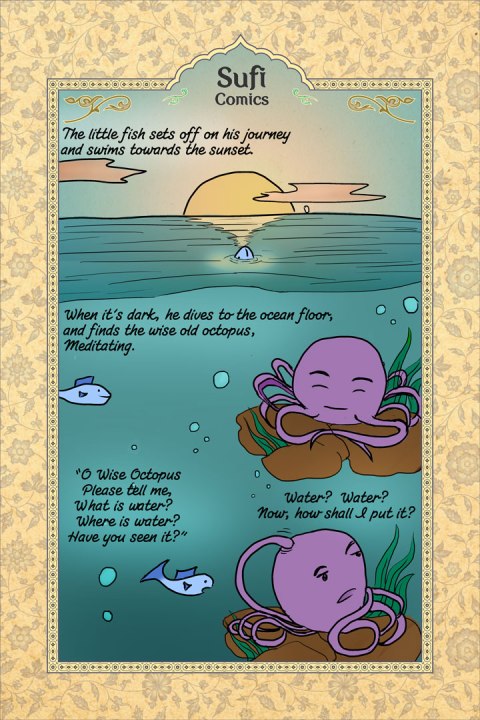
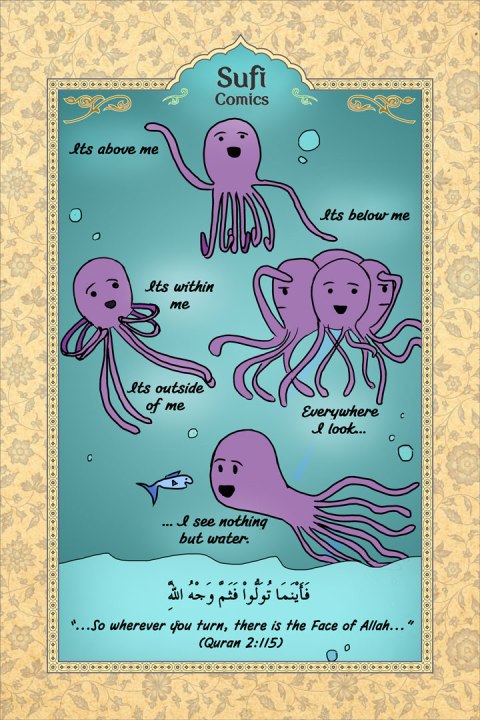



Recent Comments